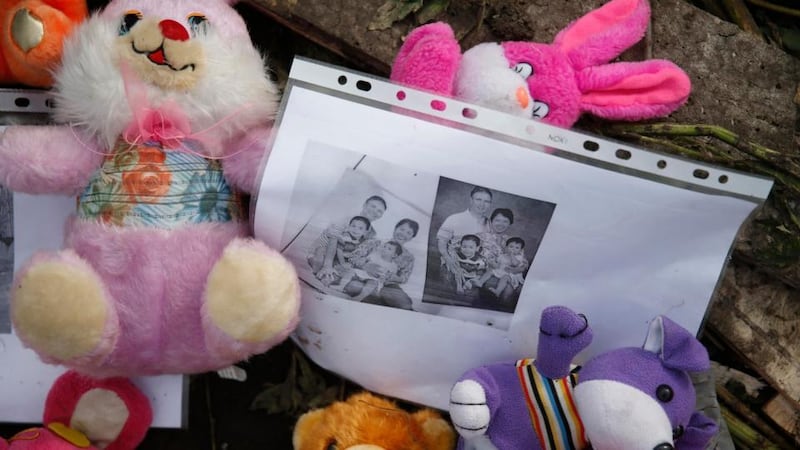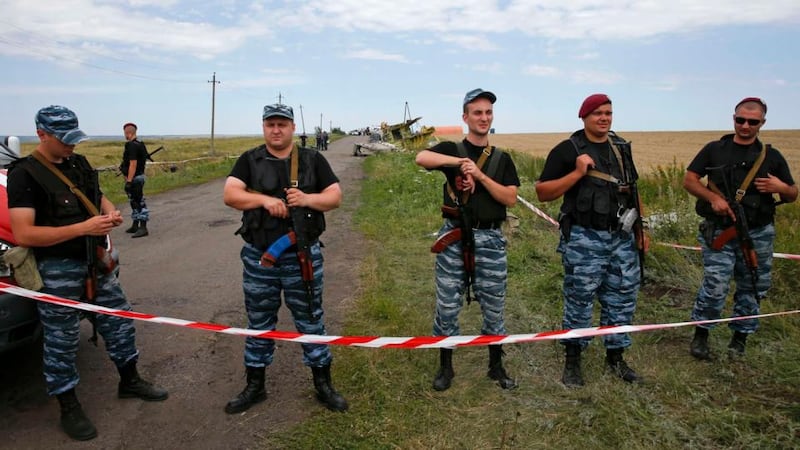Ukraine has accused separatist rebels of hiding evidence that a Russian missile was used to shoot down a Malaysian airliner, while Britain said Moscow faced "pariah" status and the threat of further economic sanctions.
At the biggest crash site, where emergency workers had bagged dozens of bodies yesterday, all had been taken away by this morning. Empty, bloodstained military stretchers that had been used to carry them lay by the road.
A separatist leader said items thought to be the stricken flight MH17’s “black boxes“ had been found and were in rebel hands.


With Western anger rising at the apparently disrespectful treatment of the bodies by the pro-Russian rebels controlling the widely spread crash sites, nearly 200 corpses had been put on a refrigerated train at Torez, 15 km away.
“It‘s corpses. They brought the bodies overnight,“ a duty officer at the town‘s station said.
A senior rebel official, Sergei Kavtaradze, said the bodies would not be moved until it had been decided what to do with them.
US secretary of state John Kerry tonight suggested that Russia had trained the separatists in the operation of SA-11 anti-aircraft missiles, the type believed to have been used to down the airliner.
“We know for certain that the separatists have a proficiency that they’ve gained by training from Russians as to how to use these sophisticated SA-11 systems,” Mr Kerry said on CNN. “We know they have the system.”
His comments constituted the first time that a US official has publicly asserted that the Russians had trained separatists in how to fire such a weapon.
US officials, who declined to be identified, said that a training area had been set up near the Russian town of Rostov, and the instruction had involved the use of major weapons systems, including tanks and short-range rockets.
Moscow denies role
Moscow denies involvement in the shooting down of Malaysia Airlines flight MH17 on Thursday and has blamed the Ukrainian military. But Washington and its allies have pointed the finger at the pro-Russian separatists who have Moscow's backing and have been accused of obstructing access to the crash sites.
Britain said Moscow could find itself isolated if it did not use its influence over the rebels to ensure safe access to the crash sites and cooperate with international investigators. “Russia risks becoming a pariah state if it does not behave properly,“ British foreign secretary Philip Hammond said on Sky television.
The downing of the airliner with the loss of nearly 300 lives has sharply escalated the crisis in Ukraine, and may mark a pivotal moment in international efforts to resolve a situation in which separatists in the Russian-speaking east have been fighting government forces since protesters in Kiev forced out a pro-Moscow president and Russia annexed Crimea.
Fresh sanctions
EU ministers should be ready to announce a fresh round of sanctions at a meeting of the foreign affairs council this week, according to a statement from British prime minister David Cameron's office, issued after calls with French president Francois Hollande and German chancellor Angela Merkel.
“They...agreed that the EU must reconsider its approach to Russia and that foreign ministers should be ready to impose further sanctions on Russia when they meet on Tuesday,“ the statement said.
The leaders also agreed to press Russian president Vladimir Putin to ensure investigators had free access to the crash site.
The UN Security Council was considering a draft resolution to condemn the attack, demand armed groups allow access to the crash sites and call on states in the region to cooperate with an international investigation.
Australia - which lost 28 citizens in the crash - circulated a draft text to the Council late last night and it could be put to a vote as early as tomorrow.
The Netherlands, whose citizens made up two-thirds of the 298 on the flight from Amsterdam to Kuala Lumpur, said it was "furious" about the manhandling of corpses strewn over open country and asked Ukraine for help to bring "our people" home.
US president Barack Obama said the disaster showed it was time to end the Ukraine conflict and Germany called it Moscow's last chance to cooperate.
European powers seemed to swing behind Washington‘s belief that Russia‘s separatist allies were to blame. That might speed new trade sanctions on Moscow, without waiting for definitive proof.
Britain, which lost 10 citizens, said further sanctions were available for use against Russia. Cameron, writing in The Sunday Times, said European countries should make their power count. “Yet we sometimes behave as if we need Russia more than Russia needs us.“
Cover-up claimed
A spokesman for Ukraine‘s Security Council, Andriy Lysenko, accused the rebels of a cover-up. “The terrorists are doing everything to hide the evidence of the involvement of Russian missiles in the shooting down of that airliner,“ he told a news conference in Kiev.
He said the rebels had taken debris and bodies from the crash site in trucks, tampering with a scene that investigators need to be secure to have a chance of determining what, and who, caused the plane to plunge into the steppe.
“The terrorists took 38 bodies to the regional hospital (in Donetsk). About the other bodies, we do not know where they could have taken them,“ Lysenko said.
A separatist leader said items thought to be the voice and data recorders from the airliner had been found.
“Some items, presumably the black boxes, were found, and they have been delivered to Donetsk and they are under our control,“ Aleksander Borodai, prime minister of the self-styled Donetsk People‘s Republic, told a news conference.
Earlier, driving home its assertion that the Boeing 777 was hit by a Russian SA-11 radar-guided missile, Ukraine‘s Western-backed government said it had “compelling evidence“ the battery was not just brought in from Russia but manned by three Russians who had now taken it back over the border.
The Wall Street Journal reported that U.S. intelligence assessments indicated that Moscow had probably provided rebels with sophisticated anti-aircraft systems in recent days.
Memorial for victims
Observers from Europe‘s OSCE security agency visited part of the crash site for a third day today. Just before their arrival, emergency workers found parts of three more bodies and put them in black body bags on the side of a road.
At the site where the cockpit fell, in a field of sunflowers near the village of Razsypnoye, residents had made a small memorial shrine of flowers, candles in tiny jars and brightly coloured teddy bears.
Photocopied pictures of children and families killed in the disaster, apparently from news coverage of the victims, had been set out on the grass.
All bodies, including that of a woman who had lain naked under a tarp about 50 metres away, had been removed.
“There were five or six over here, and two or three over there,“ said a young man with a rifle guarding the site, who declined to give his name. “They took the bodies away to the morgue. Firstly, they were decomposing. And secondly, the smell was horrible.“
Reuters










